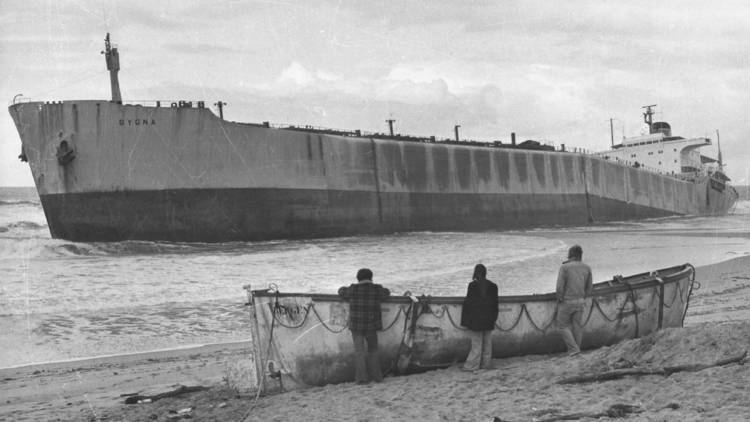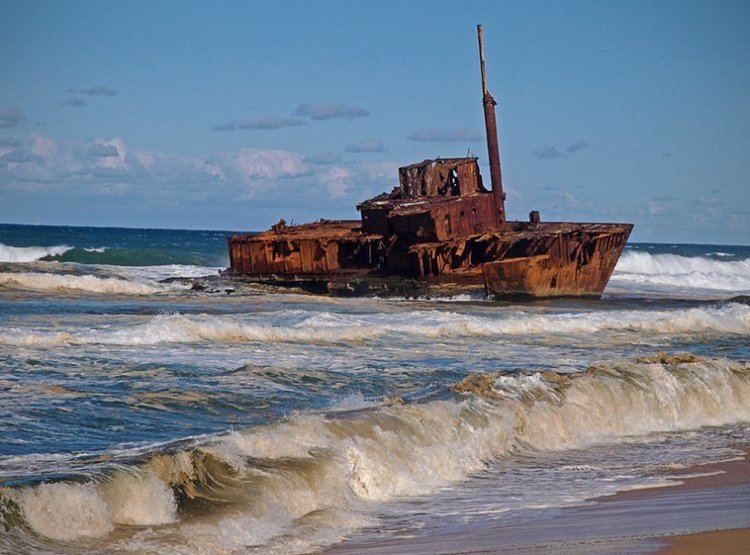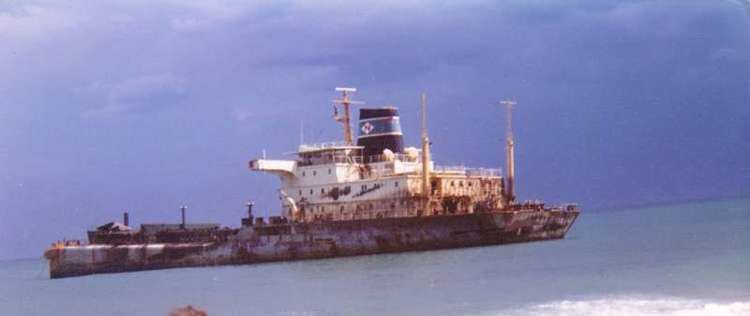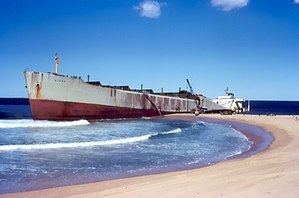Name Sygna Out of service 26 May 1974 Launched 1967 | Yard number 845 Length 217 m Draft 13 m | |
 | ||
Builder Austin and Pickersgill, Sunderland Fate Ran aground on Stockton Beach, New South Wales, Australia during storm on 26 May 1974 | ||
Mv sygna shipwreck stockton nsw
The MV Sygna was a 53,000 tonne Norwegian bulk carrier and now shipwreck on Stockton Beach in the Port Stephens LGA in New South Wales, Australia. The ship ran aground during a major storm on 26 May 1974 and the wreck has become an icon and landmark for the local area.
Contents
- Mv sygna shipwreck stockton nsw
- Mv sygna wreck stockon beach 1995 home movie
- Storm
- Beaching
- Salvage operations
- Icon
- References
Mv sygna wreck stockon beach 1995 home movie
Storm

During May 1974 the New South Wales coast was being battered by large storms which brought heavy swells off both Sydney and Newcastle ports. Newcastle port reported a swell of over 17 m (56 ft) at the entrance.

The Sygna was on its maiden voyage, waiting for a load of 50,000 tonnes of coal destined for Europe at the time of the accident. It was anchored 4 kilometres (2.5 mi) off Newcastle when the Bureau of Meteorology issued a severe storm warning and directive for ships to move out to sea. Seven of the ten ships anchored off Newcastle did so, however the Sygna was not one of them.
Beaching

Early the following morning, with winds gusting at 165 km/h (89.1 kn), the captain issued orders to set sail. Unfortunately, even with its engines at full-ahead the Sygna was unable to make any headway and the storm turned it parallel to the beach. It is reported that within 30 minutes it had run aground on Stockton Beach.

With heavy seas pounding the stricken ship, its captain radioed a Mayday and gave the order to abandon ship. An Iroquois helicopter from RAAF Williamtown’s Search and Rescue (SAR) Squadron flown by Flt Lt Gary McFarlane, attended the scene and slowly rescued the 31 trapped sailors from the ship in near cyclone conditions. Fortunately, no one was injured or killed in the incident. Gary McFarlane was awarded the Air Force Cross (AFC), with other members of his crew receiving commendations for their heroic efforts during the rescue.

The Sygna lost approximately 700 tonnes of oil during the accident. This oil was mostly dispersed by the heavy seas, and as such no cleanup or recovery action was undertaken.
Salvage operations
After the storm had subsided the salvage operation commenced. The ship was swung around, which caused the heavier stern section to sink into deeper water. This caused the ship to break its back.
On 4 September a salvage team led by Japanese millionaire Kitoku Yamada refloated the ship after repairing several holes in the hull and then pumping out thousands of tonnes of water. The stern section was refloated first, followed by the bow, which had been resting deep in the sand. The bow remained afloat but unfortunately for the salvagers the stern again went aground about 80 m (262 ft) out from the beach and gradually settled in the sand as salvage crews stripped it of all items of value.
In November 1974 another salvage attempt was made of the stern of the Sygna. This caused a very heavy oil spillage, which spread along a 16 kilometres (10 mi) stretch of Stockton Beach. Bulldozers attempted to bury the oil in the sand above the high-water mark. After lying in Salamander Bay in Port Stephens for almost two years the bow section was towed away and broken up in Taiwan.
Icon
The stern still lies on Stockton beach and it has slowly been decaying from the harsh elements in its environment. However, it remains as an icon and landmark for the local area. According to the Newcastle port authority, the Sygna is the last of 59 ships which have been lost on Newcastle shores, although it was first feared that the MV Pasha Bulker would join it as a new Newcastle icon after it ran aground on Nobby's Beach (8.4 kilometres (5 mi) south of the Sygna wreck) on 8 June 2007. The Pasha Bulker was successfully re-floated on 2 July 2007 leaving the Sygna with its title.
On 14 January 2010 it was reported that the National Parks and Wildlife Service and shipping experts believed that the Sygna could rust to the waterline within ten years. During storms on the weekend of 4–5 June 2016, the remaining superstructure collapsed into the ocean, leaving only a small part of the hull still showing above the waterline.
